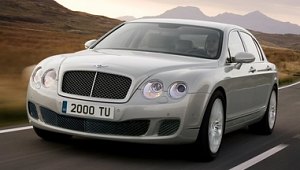Bentley Continental
Flying Spur
Debut: 2005 |
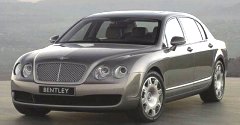 Strangely,
Continental Flying Spur - the sedan version of Continental GT - is
introduced some two years after the coupe. This is very unusual in the
automotive industry because everyone else develop sedans first and then
coupes. In fact, Volkswagen is very clever. If it introduced
Continental Flying Spur two years ago, people could have compared it
with Maybach and Rolls-Royce Phantom. That would have been an up-hill
battle, not easy to establish a successful image for the reborn
Bentley. In contrast, the Continental GT landed on a new market segment
without any competitors. It used its beauty, performance and quality to
attract more than 5,000 sales last year, bringing Volkswagen group the
first profit from its investment in Bentley. Strangely,
Continental Flying Spur - the sedan version of Continental GT - is
introduced some two years after the coupe. This is very unusual in the
automotive industry because everyone else develop sedans first and then
coupes. In fact, Volkswagen is very clever. If it introduced
Continental Flying Spur two years ago, people could have compared it
with Maybach and Rolls-Royce Phantom. That would have been an up-hill
battle, not easy to establish a successful image for the reborn
Bentley. In contrast, the Continental GT landed on a new market segment
without any competitors. It used its beauty, performance and quality to
attract more than 5,000 sales last year, bringing Volkswagen group the
first profit from its investment in Bentley. After the successful opening, Bentley can expand the Continental line to a 4-door sedan. The sales target is 3500 cars in its first full year of production. That could lift the volume of Bentley to a record 10,000 units. Unbelievable ! 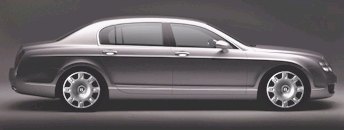 You had better to believe,
because Flying Spur is as good as the GT. Basically, the underpinnings
of the cars are the same - the same 560 horsepower twin-turbo 6.0-litre
W12 engine, the same 6-speed automatic transmission, the same
4-wheel-drive system, the same suspensions with adaptive air springs
and variable damping… they are therefore close sisters to Volkswagen
Phaeton. In fact, Volkswagen is going to build the Flying Spur at its
Dresden factory in Germany alongside the Phaeton. This is because the
production line at Crewe (England) is being occupied by the
strong-selling Continental GT while the slow-selling Phaeton leaves a
lot of excess capacity at Dresden. You had better to believe,
because Flying Spur is as good as the GT. Basically, the underpinnings
of the cars are the same - the same 560 horsepower twin-turbo 6.0-litre
W12 engine, the same 6-speed automatic transmission, the same
4-wheel-drive system, the same suspensions with adaptive air springs
and variable damping… they are therefore close sisters to Volkswagen
Phaeton. In fact, Volkswagen is going to build the Flying Spur at its
Dresden factory in Germany alongside the Phaeton. This is because the
production line at Crewe (England) is being occupied by the
strong-selling Continental GT while the slow-selling Phaeton leaves a
lot of excess capacity at Dresden.The similarity between the sedan and the GT is not limited to the mechanical side, but also the packaging and styling. Basically, the Flying Spur retains all the styling features of the GT, just reshaped to provide (320 mm) longer wheelbase, (90 mm) taller roof, 4 doors and more interior volume. Inevitably, its windscreen angle is raised, so is the rear window angle. To provide a decent luggage space (the GT's boot is too small), the boot is stretched and made squarer. As a result, the sedan is 500 mm longer overall than the GT. However, these changes did little to alter the family look and beautiful styling of the car. In fact, many people regard the Flying Spur's design is more coherence and original than the GT. 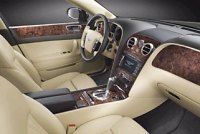 Inside, the similarity with
Continental GT continues. You can find the same beautiful dashboard,
the same high quality materials and craftsmanship. In terms of
desirability, this cabin can shame a Maybach and make RR Phantom
hopelessly conservative. It combines the best of the two worlds -
Volkswagen group's high-quality standard and the best British
craftsmanship. Inside, the similarity with
Continental GT continues. You can find the same beautiful dashboard,
the same high quality materials and craftsmanship. In terms of
desirability, this cabin can shame a Maybach and make RR Phantom
hopelessly conservative. It combines the best of the two worlds -
Volkswagen group's high-quality standard and the best British
craftsmanship. 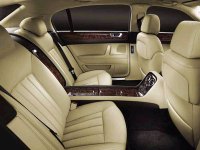 All seats are big and
comfortable, with mass of legroom and headroom - the taller roof gives
Flying Spur so much more freedom than the GT. You can order the Flying
Spur in 5-seat form or 4-seat form, the latter incorporates a
full-length center console running between the two rear seats. However,
you can't find the most luxurious equipment as in Maybach and
Rolls-Royce, because the Bentley is sold for "only" £115,000, or
half the price of the aforementioned rivals. All seats are big and
comfortable, with mass of legroom and headroom - the taller roof gives
Flying Spur so much more freedom than the GT. You can order the Flying
Spur in 5-seat form or 4-seat form, the latter incorporates a
full-length center console running between the two rear seats. However,
you can't find the most luxurious equipment as in Maybach and
Rolls-Royce, because the Bentley is sold for "only" £115,000, or
half the price of the aforementioned rivals. Amazingly, the sedan is only 90 kg heavier than the coupe, thanks to some weight cutting measures taken, such as converting the rear subframe from steel to aluminum. Because the engine is the same, it goes almost as quick as Continental GT: 0-60 mph takes just 4.9 seconds, while top speed is an astonishing 198 mph.... Wow, that's faster than Ferrari F430, Lamborghini Gallardo and Porsche 911 GT2 !! Bentley claims the Continental Flying Spur is the world's fastest saloon. Of course, on the top of that there are some assumptions: 1) it talks about top speed rather than acceleration. 2) It assumes the drivers of Mercedes S65 won't ask AMG to de-limit their cars. Anyway, Continental Flying Spur is not supposed to be a sports sedan. The mission of its twin-turbo W12 is to provide ample torque to pull the 2.5-ton car at ease, no matter at any rpm. In this respect, it is fully successful. From merely 1600 rpm, the W12 already pumps out its maximum 479 lbft of torque. This remains constant until 6000 rpm, enabling an effortless performance that every Bentley customer appreciates. In fact, the torque bias manner of the engine suits Flying Spur even more than the GT. 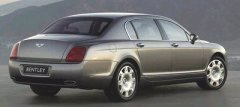 Another
surprise: it even handles and rides better than the GT. The longer
wheelbase and tail help its chassis to achieve better balance. In
addition to revised damper setting and uprated anti-roll bars, the
Flying Spur turns into corner keener and displays less understeer. At
the same time, it retains the other qualities of the GT, that is,
4-wheel drive traction, precise and well-weighted steering and
reassuring braking from the monster-size, 405 mm diameter front discs.
High speed traveling on motorway reveals good stability, thanks to the
diffusers incorporated under the tail. Another
surprise: it even handles and rides better than the GT. The longer
wheelbase and tail help its chassis to achieve better balance. In
addition to revised damper setting and uprated anti-roll bars, the
Flying Spur turns into corner keener and displays less understeer. At
the same time, it retains the other qualities of the GT, that is,
4-wheel drive traction, precise and well-weighted steering and
reassuring braking from the monster-size, 405 mm diameter front discs.
High speed traveling on motorway reveals good stability, thanks to the
diffusers incorporated under the tail. The ride quality from the adaptive air suspensions is good, if not in the league of Mercedes S-class and Lexus LS430. The cabin is not as well insulated as these cars too, because there is too much wind noise entering the cabin. Strangely, Volkswagen did not apply the noise-insulation experience learned from the Phaeton to the Bentley. In terms of refinement, the Continental Flying Spur is a bit disappointing. Another problem is the appalling fuel consumption, officially rated at 16 mpg but could be lower in real world. That limit the traveling range to 250 miles or less. Ridiculously, Continental Flying Spur is not all that suitable for flying over the continent. That said, the new Bentley saloon is still an excellent luxurious car. Being beautifully styled and impeccably built, it is definitely the most desirable luxurious car on the market regardless of price. Mass production cars like Mercedes S-class and BMW 7-Series can never threaten it because they lack the exclusivity of the Bentley. Maybach and Rolls-Royce cost double the price, so they are not competitors too. That means Bentley once again slipped into a new market segment. Undoubtedly, it will be another great success. |
| The above report was last updated on 22 May 2005. All Rights Reserved. |
